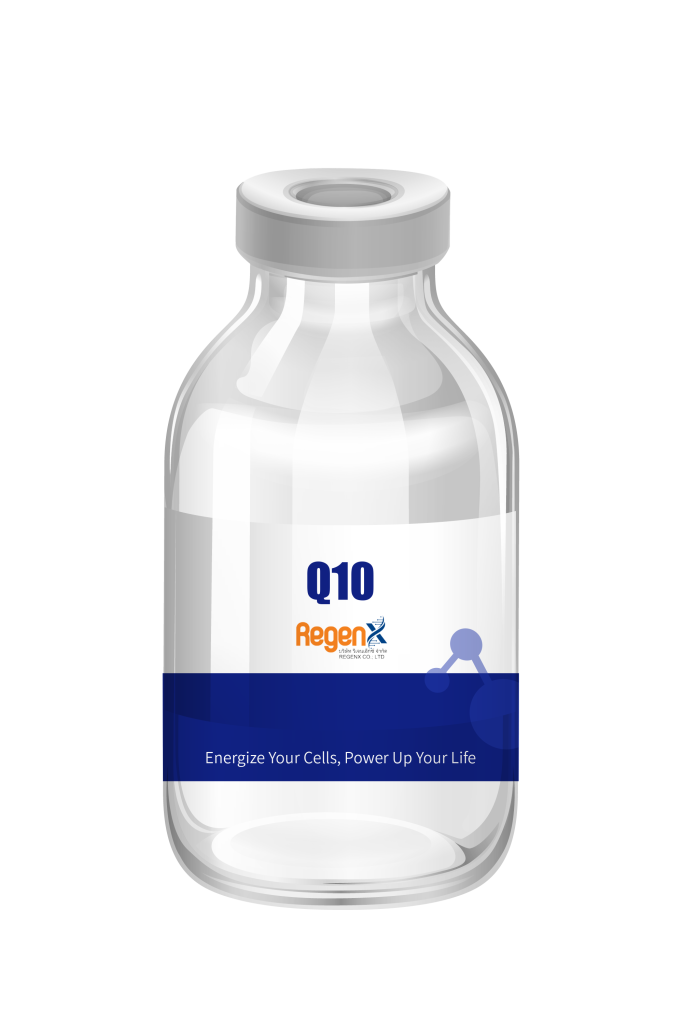Energize Your Cells, Power Up Your Life
CoQ10 IV Therapy
Coenzyme Q10 (CoQ10), also known as ubiquinone, is a naturally occurring compound found in every cell of the human body. It plays a crucial role in the production of energy within cells and also functions as an antioxidant, helping to protect cells from oxidative stress and damage. CoQ10 is particularly important for the proper functioning of organs with high energy demands, such as the heart, liver, and muscles.
Intravenous (IV) therapy involves the administration of fluids, nutrients, or medications directly into a patient’s bloodstream. CoQ10 IV therapy, as the name suggests, refers to the intravenous infusion of CoQ10 directly into the veins. This method of administration allows for more rapid absorption and higher bioavailability compared to oral supplements.

Energize Life with CoQ10: Powering Your Vitality Within!

ANTI-AGING AND SKIN HEALTH
CoQ10's antioxidant properties may contribute to healthier skin by reducing oxidative stress and promoting a more youthful appearance.

ANTIOXIDANT DEFENSE
CoQ10's antioxidant properties could be harnessed through IV therapy to counteract oxidative stress and reduce cellular damage.

CARDIOVASCULAR SUPPORT
CoQ10's role in energy production and heart health makes IV therapy a concentrated way to potentially improve cardiac function, reduce heart condition symptoms, and aid in managing blood pressure.

NEUROPROTECTIVE EFFECTS
CoQ10 IV therapy could deliver neuroprotective benefits by efficiently providing CoQ10 to the brain, potentially contributing to conditions like Parkinson's disease and cognitive decline.

MITOCHONDRIAL HEALTH
CoQ10 supports mitochondrial health by aiding in the production of cellular energy. As a key player in the mitochondrial electron transport chain, CoQ10 contributes to efficient energy generation. This could potentially benefit various bodily functions and systems that rely heavily on energy, promoting overall mitochondrial well-being.

ENHANCES BLOOD SUGAR CONTROL
CoQ10 may contribute to better blood sugar regulation by assisting cells in energy production. This could potentially lead to improved insulin sensitivity and glucose utilization, supporting overall blood sugar management. While research is ongoing, CoQ10's role in cellular energy processes suggests it might have a positive impact on blood sugar levels.
In essence, CoQ10 IV therapy presents a novel avenue in medical intervention, offering a unique means of delivering CoQ10’s benefits to the body. As our understanding grows, this method might pave the way for innovative approaches to address health challenges and enhance well-being, ushering in a new chapter in medical science.
FAQ: Your Comprehensive Guide
What is CoQ10 IV Therapy?
Coenzyme Q10 (CoQ10) serves as a built-in antioxidant, naturally crafted by your body to support cell growth and maintenance.
As time progresses, your body’s CoQ10 levels experience a gradual decrease. This phenomenon is especially notable among individuals with specific conditions like heart disease, as well as those who rely on cholesterol-lowering drugs like statins, where CoQ10 levels tend to be lower.
How does CoQ10 IV Therapy work?
CoQ10 IV Therapy involves directly infusing Coenzyme Q10 into your bloodstream through intravenous administration. This targeted approach allows for rapid absorption and potential benefits for energy production, cardiovascular health, and antioxidant support.
How long does a session take?
The infusion process typically lasts around 15 to 60 minutes, depending on the specific formulation and your individual needs.
Will I feel any immediate effects?
Some people report feeling a burst of energy or warmth during the infusion. However, the extent of immediate effects can vary. Long-term benefits might become more apparent with consistent treatments.
Is CoQ10 IV Therapy covered by insurance?
To determine if CoQ10 IV Therapy is covered by your insurance, it’s recommended to contact your insurance provider directly. They can provide information about coverage options, eligibility criteria, and any potential out-of-pocket costs associated with the therapy.
